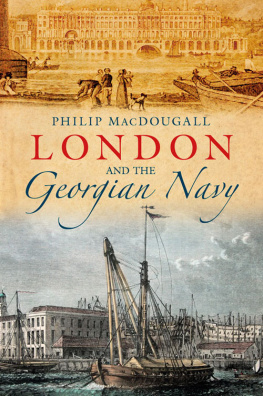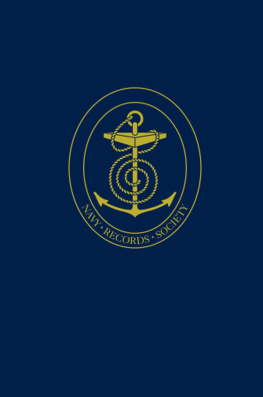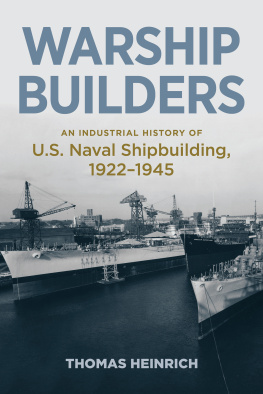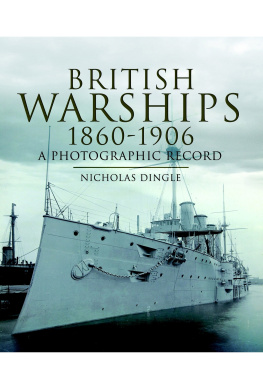
Ocelot, the last Royal Navy submarine to be built at Chatham, is one of three important warships currently open to public boarding in the historic enclave of the dockyard that is now managed by the Chatham Dockyard Historic Trust.
Frontispiece: Achilles, laid down in the No.2 Dock at Chatham in August 1861. Achilles represented the start of a new era for Chatham as she was the first iron-built battleship to be built in any government yard. The ship is seen in 1864 undergoing completion prior to her commissioning into the Channel Squadron.
C ONTENTS
In acquiring this book it might initially be wondered whether it is simply a reissue of my earlier history of the dockyard that was published in two editions during the 1980s. Of this it needs to be made absolutely clear; this book is a completely new history of the massive industrial complex that was Chatham dockyard. Of that earlier book, this has been out of print for nearly twenty years. While there has always been considerable interest in having the book reprinted, my own continued interest in the dockyard has resulted in the unearthing of considerable new material. It would therefore be unfortunate if the opportunity were not taken to include this new research, so making this book complementary to the earlier book rather than a simple update.
So, how are the two books different? First and foremost, the earlier book directed an equal amount of attention to all periods of the dockyards history and did not attempt a more detailed study of any particular period. In this new history, attention is directed to the later years. It is here to which much of the new research undertaken has been directed, so permitting a better understanding of how Chatham dockyard was affected by the Industrial Revolution and, in turn, greatly contributed to the bringing about of a number of essential improvements in technology and workforce management.
Chatham dockyard, from its creation in the latter years of the sixteenth century, through to its final closure in 1984, was a military industrial complex of some considerable significance. At times it was employing the largest number of civilian workers to be found in any single industrial enterprise in Britain, with numbers employed during the late seventeenth century averaging 900 and going on to reach a massive 2,000 artisans and labourers by the early nineteenth century. While Portsmouth has often been regarded as the largest and most important of the home yards, this is only correct for certain periods of history. From its inception and continuing into the first decades of the eighteenth century, Chatham was not only the most important of the royal dockyards but came close to being the largest and most energetic naval dockyard in the world. In effect, it was only the state-owned Ottoman yard of Constantinople and the declining yard of Venice that were of a size that overshadowed the repair and building capacity of the yard at Chatham.
Much of the new material that has been used to inform this book has come from the National Maritime Museum (NMM), the National Archives (TNA), the Royal Naval Museum (RNM) and the Scottish Records Office (SRO). This has allowed for more careful focusing on the mid-eighteenth century through to the late nineteenth century. In addition, and to make up for an earlier shortage of material relating to the dockyard during the final decades prior to its closure, more attention has also been given to this period. While the earlier book looked at these final years through a series of interviews that I conducted with some of those who were employed in the yard, a considerable amount of new material has now emerged. This has been used to provide a more useful glimpse of a dockyard workforce that had been promised much by successive governments but was ultimately sacrificed.
Philip MacDougall (Dr)
1
The founding date of Chatham dockyard lies somewhere between the years 1567 and 1572; as to the precise year, much depends on what significant event might be regarded as of sufficient importance to constitute the founding of such an important future military-industrial complex. Was it the initial planning, undertaken around 1567, or would it be the work that begun during the following year on both clearing the site and preparing the foundations? Alternatively, it could be the completion of the first usable facility or the later raising of the flag of St George that announced the site to be that of a working naval ship repair facility.
Of one thing that is clear, the frequent suggestion of a much earlier date for the founding of the dockyard, and one that roots back to the early sixteenth century, is most certainly incorrect. Such a suggestion refers to a very different event. Instead of the formation of the dockyard, it is the period in which the river Medway was being developed as a naval supply base and safe anchorage. This in itself is important, the Medway at that time being utilised by an increasing number of royal ships that were using the river as a winter home. During the early part of his reign, Henry VIII (150947), having established a fairly sizeable navy, determined upon bringing an increasing number of these ships into the Medway, knowing that they would be safe from all but the most severe winter storms. Eventually it was decided to turn this into a more permanent arrangement when, in 1547, a building for the storage of maritime equipment was hired at a cost of 13s 4d per year, this located alongside Jillyngham Water.
From 1547, the annual statement of accounts, as presented to the Exchequer, shows the continued payment of rents, with the amounts steadily rising as the demand for storehouses increased. By the year 1561, the cost to the Exchequer had more than quadrupled:
Also paide by the said Accomptants for the rents and hyer of Storehouses for the storage of part of the said provisions viz. at Deptford Strand 105s. Jillingham 60s 5d.
Unfortunately, nothing is said of the more precise location of these buildings. Certainly it would be wrong to jump to the conclusion that the storehouses were all located close to the river at Jillingham. The subsequent construction of the dockyard at Chatham combined with the use of Chatham Reach, rather than Gillingham Reach, as the favoured stretch for the mooring of ships, would suggest many of these storehouses lay within the parish of Chatham. Perhaps only the first rented storehouse was located in Jillingham, with the name subsequently used as shorthand for all Medway storehouses, irrespective of where they were located. A recent archaeological dig has certainly revealed evidence of an early Tudor storehouse located below St Marys church, where the subsequent Elizabethan dockyard was built.
The increasing value placed upon the Medway as a naval anchorage is amply demonstrated by two sets of orders from 1550. In June the Lord High Admiral was informed:
That the Kinges shipps shulde be harborowed in Jillingham Water, saving those that be at Portsmouth, to remaigne there till the yere be further spent, for avoiding of all inconveniences, and that all masters of shippes, gonnes and pursers be discharged except a convenient nombre, till the danger of the yere be past, and afterwards ordered as it hath been accustomed in time of peace.
Admittedly, in having brought warships to the Medway, the government did not simply leave them neglected or untended. A small crew of ship keepers would have remained on board to assist in preparing the vessels for the following season. Items of ageing equipment would have been renewed while rotting timbers were cut out and replaced. From the storehouses, those responsible for the upkeep of these vessels would have been able to draw such necessities as rope, pulley blocks, ships timbers and sail cloth. Such tasks must certainly have been undertaken upon ships brought into the Medway prior to 1547, but it is only in that year that accurate surviving financial records begin to provide absolute evidence. In that year, it is clearly stated that 4,167 was expended on maintaining and preparing ships in the Medway, this in addition to the hiring of a storehouse and a separate reference to the employment of a victualler and clerk.
Next page












